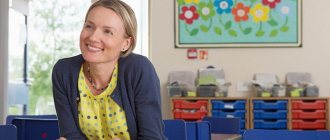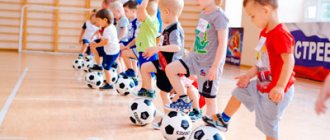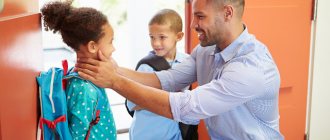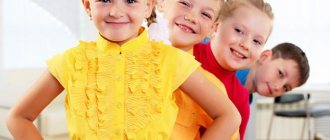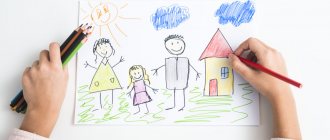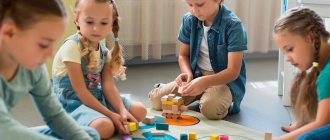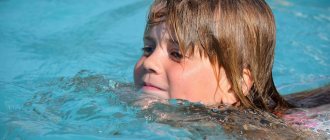The issue of protecting and strengthening the physical condition of children is considered one of the most important in almost all kindergartens. In this direction, work is carried out based on compliance with requirements and sanitary and hygienic standards, the correct approach to organizing a balanced diet, systematic hardening of children, as well as physical education and health activities.
Today, physical education for children in preschool educational institutions is of particular importance. According to statistics, in Russia in recent years the number of children aged from 3 to 7 years who are distinguished by functional deviations in health has increased to 60%. The main task of the kindergarten is the correct individual approach to each child in order to positively influence the current situation.
The importance of physical education in kindergarten for ordinary children and children with disabilities
For most children, physical education is an opportunity to become full-fledged members of society in the future. If you correctly engage in physical exercises with a preschool child with a problem that they understand, he will learn to interact with his peers, striving for his first achievements and development.
As for children with disabilities (Limited Health Opportunities), there is an individual approach for them, taking into account the following features:
- correctional and compensatory work. It involves the selection of exercises, taking into account the main and possible associated ailments. In this case, it is customary to use an integrated approach that promotes the development of physical abilities;
- preventive measures. This part is one of the most important, as it allows you to increase vitality, as well as health, improve overall well-being and strengthen the immune system;
- psychology. Often the main reason for a child’s antisocial behavior is lack of self-confidence and self-confidence. As a result, the child does not understand his role in society and does not know how to interact with peers. Therefore, an integrated approach is designed to help the child overcome such problems;
- physical education with children with disabilities in preschool educational institutions also includes educational upbringing. This means that all children with similar problems should be taught sports culture, as well as the rules of competition, which will help them gain the skills to work with other children in a team and subsequently make sports an integral part of their lives.
Note! The main exercises for children with disabilities include activities that are aimed at acquiring the most important everyday skills, which include fine motor skills of the hands, micro-orientation, and leg movements.
All these exercises are always based on provisions about the physical and psychological characteristics of the baby, as well as special methodological principles for working with each of them. For a child without disabilities, physical exercise also plays a very important role. Exercise not only promotes health, but also physical development. Physical education can help mental activity and also has a beneficial effect on the body as a whole. In this regard, educators take the following measures:
- Morning work-out. It always has a beneficial effect on increasing performance and also improves well-being for the whole day.
- Short bursts of physical exercise. They are designed to relieve fatigue and increase mental capacity in order to relieve the child from the feeling of overwork.
- Various types of hardening with parental permission. Holding physical education holidays, which are designed not only to improve well-being, but also to promote physical development, have a positive effect on the emotional state of the child, which in the future will help him perceive physical exercise as a way to improve his mood.
- In addition to morning exercises, this includes such types as finger, articulation and breathing.
- For each group, special physical activity regimes are always compiled, in which, in addition to organized varieties of physical education exercises, independent outdoor games are included in the daily routine of preschoolers, taking into account their individual and age-related characteristics.
Physical education in kindergarten
Author: Yulia Aleksandrovna Vildanova, teacher of preschool groups at the Kirpichnozavodskaya Secondary School
Abstract: This article describes the types of physical education and health activities organized in kindergarten, taking into account the age and individual characteristics of the child.
Key words: physical education, kindergarten, gymnastics, pupil, health.
Issues of protecting and promoting the health of children and preschoolers are one of the important areas of activity of a preschool institution. The work is carried out through compliance with sanitary and hygienic standards and requirements, organizing a balanced diet, a system of hardening children, conducting physical education and recreational activities, and creating a favorable climate in the preschool educational institution.
Educators and physical education teachers conduct various types of physical education and health work:
• direct educational activities;
• physical education sessions;
•varieties of gymnastics (morning, breathing, finger, articulation, etc.);
• various types of hardening;
• health days;
• physical education holidays, leisure time
A physical activity regime has been compiled for all groups, where, in addition to organized types of physical education classes in the daily routine of preschoolers, a significant place is allocated to independent motor games, taking into account their age and individual characteristics.
As you know, regular physical exercise strengthens the body and improves immunity. Classes are held 3 times a week, 2 times in the gym and 1 time outside. Their duration, like other classes in kindergarten, is from 15 to 30 minutes. This is due to the fact that it is very difficult to hold the child’s attention for longer than this time.
In addition to direct educational activities in physical education, morning exercises are carried out daily in kindergarten, which consists of turning and tilting the head, swinging the arms, bending the torso, and squats. The duration of morning exercises is 5-8 minutes. In the breaks between “sedentary” activities and after naps, so-called five-minute physical education sessions are also held, giving the child the opportunity to stretch his body.
The child must have a special uniform for physical education - this is, first of all, a matter of hygiene. Shorts and a T-shirt made of non-synthetic, breathable materials are perfect for physical education. You can wear shoes or socks with rubberized (non-slip) soles on your feet. In many groups, physical education uniforms are of a certain color. This develops team spirit in children during relay races and sports events.
Much attention in the process of direct educational activities is paid to the formation of correct posture, motor skills, as well as the instillation of cultural and hygienic skills and interest in physical exercise, which contributes to the formation of moral qualities, strong-willed personality traits, and maintaining a healthy lifestyle.
Throughout the year, children enjoy sports events, leisure activities, entertainment, and outdoor sports games.
During the summer recreational period, classes are held in the fresh air with direct contact with natural factors. Summer classes are held in a more playful form, filled with sports and outdoor games, and nursery rhymes.
The main goal of physical education in a preschool institution is to satisfy the natural biological need of children to move, to achieve a good level of health and comprehensive physical development of children. And also ensure that preschoolers master motor skills and abilities; create conditions for the versatile (mental, moral, aesthetic) development of children and instill in them the need for systematic physical exercise.
Features of physical education in modern kindergartens
The physical development of the baby is the object of constant monitoring by specialists, both pedagogical and medical. Therefore, the task of each institution that draws up physical education projects in preschool educational institutions with children is to prepare such programs that will fully meet the requirements of these specialists.
Modern pedagogical practice allows for the only form of work with children, this includes traditional classes that contribute to achieving positive dynamics in the matter of the child’s physical development. All methods of conducting physical education exercises in preschool institutions are based on the need to solve 2 most important problems:
- organization of such a health complex that promotes the formation of an optimal sequence of movement and gradual increases in physical activity, which will further help strengthen the child’s immunity, and also have a positive effect on stimulating psychophysiological development. This will prevent the development of many pathological changes in the body;
- meeting age-related needs for physical exercise, which should be perceived by every child as “muscular joy”, and by educators as the main means of comprehensive development of preschool children. During such physical education classes, children not only understand the characteristics and capabilities of their body, but also communicate with peers through competitions in attentiveness and dexterity.
Goals and objectives of physical education classes in kindergarten
Preschool children have a very high level of physical activity.
Without movement, the comprehensive and harmonious development of a child is impossible, therefore, special attention is given to physical education classes in preschool educational institutions. Physical education practice with children is a separate area, which is dealt with by experienced specialists. This work requires from the teacher not only general knowledge of organizing and conducting classes, but also knowledge about the age characteristics of preschoolers. Introducing to physical education at an early age affects the child's condition in the future, and can also have an impact on his lifestyle as a teenager and adult. The Federal State Educational Standard (FSES) defines the key goals of conducting classes in preschool educational institutions, that is, in kindergartens. These goals include:
Are you an expert in this subject area? We invite you to become the author of the Directory Working Conditions
- Development of the child’s physical qualities, including speed, endurance and strength, coordination of movements;
- Improving the above physical qualities;
- Prevention of possible developmental disorders of the musculoskeletal system through regular training and gradual complication of some exercises;
- Formation of basic cultural and hygienic skills - in the process of classes, the child not only develops physically, but also acquires some skills and useful habits. For example, washing your hands before eating, after a walk; washing, brushing teeth 2 times a day; the ability to dress according to the weather so as not to get sick from hypothermia.
Classes in kindergarten help introduce a child to a healthy lifestyle from an early age - in the younger group, kids walk barefoot in the sandbox on warm days, in the middle group they wash themselves with cool water, in the older group they do exercises in the fresh air at any time of the year. In this way, the child gradually gets accustomed to physical education not under duress, but with pleasure, and sport becomes part of his lifestyle. While the child is small, his psyche is just beginning to form, which means that some concepts and habits can be embedded in it, including habits related to hygiene and sports. Even teaching a child to do daily gymnastics and morning exercises can lead to the fact that at a more mature age a person will engage in active sports and even achieve some success in it.
Finished works on a similar topic
Course work Physical education for preschool children 460 ₽ Abstract Physical education for preschool children 230 ₽ Test paper Physical education for preschool children 200 ₽
Receive completed work or specialist advice on your educational project Find out the cost
The goals listed above are specified by a number of tasks. They are more private in nature; each age group of kindergarten solves its own problems. For example, in the younger group, children must learn to jump on the spot, master the manipulation of a ball and other available sports materials and sports equipment. In the middle group, classes gradually become more difficult. The child learns to climb a gymnastic wall, maintain balance, and improves the culture of movements so that they become more flexible and expressive. In middle groups, children can be united for team play, but it should not be too difficult, since the child does not yet remember all the rules. In older groups, the basic principles of the culture of sports behavior are mastered and the plasticity of movements is improved. The teacher also has the opportunity to stimulate his students’ interest in sports, thanks to which some children begin to attend professional sports sections. In preparatory groups, the ability to maintain balance is trained, the skill of predicting motor activity is formed, and the desire to organize group games with peers is encouraged.
Standard sets of exercises
If a child constantly exercises, his appetite and activity increase throughout the day. All exercises are selected in such a way as to affect the muscles of the spine, neck, lower back, shoulders, limbs and pelvis. The main goal pursued by educators is to influence the strengthening of the musculoskeletal system, as well as the prevention of diseases such as scoliosis.
It is best to do exercises in the fresh air, which is what all educators try to do in the warm seasons, and in winter a ventilated room is well suited, usually a sports or music room. Gymnastics along with hardening have a very good effect on a child’s body. In the future, this has a positive effect on the baby’s immune system and resistance to many diseases.
The set of exercises includes three stages:
- introductory part. Exercises (rotations of the head, circular movements of the arms, turns of the torso, bending);
- basic exercises. Stretching the muscles of the arms, legs and back, squats with gradually increasing repetitions, push-ups (if possible);
- final part. Light jogging with a step, shaking the muscles to relax.
The first stage includes various types of walking, as well as running, which are necessary to gradually activate different muscle groups. Next, you can begin exercises that will help strengthen and strengthen muscles, as well as joint mobility, posture and coordination. As for the final part, this usually includes some types of gymnastics and moderate walking.
Options for organizing physical education classes
- A set of individual exercises. In this case, each child is given his own task. By doing it, he improves his results.
- Group classes (from 4 to 6 people in a group). With this organization, each group receives its own task, trains, and after a given time, moves on to the next exercise.
- Group activity. During it, all children must perform the same exercise. To achieve the participation of all children, tasks should be given simple ones that do not require special skills. These can be outdoor games.
